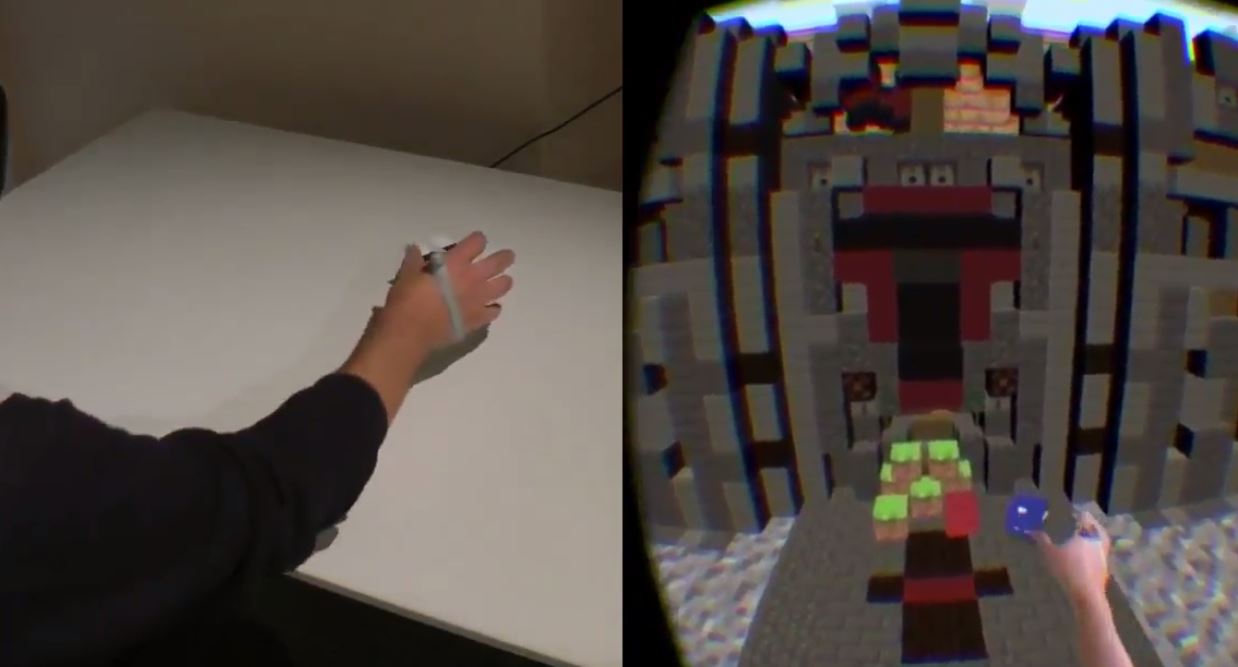Microsoft’s Haptic Retargeting Tricks People in VR
The biggest challenge in the effort of making Virtual Reality a more believable experience is providing a sense of touch to the virtual environment. It was the obvious step in the development of virtual reality technologies, many tech companies are already trying their best and worst to add additional senses to their products, so it was about time for VR to try new things to deliver a more immersive experience.
We have seen this before, we have had gun controllers for shooters long before VR was even a possibility, there are also bows, microphones, guitars and all kind of stuff. But what if certain video game or app needs the manipulation of several items? It would be quite unpractical to carry dozens of different objects and your computer would have it really hard trying to track too many stuff at the same time.

Body Warping and World Warping
A research team from the University of Waterloo, the University of South Carolina, and Microsoft developed this year a couple of interesting techniques, world warping and body warping in virtual reality. They basically trick your senses and your mind to make you believe that you are using several objects but in reality, there is just one. It can also make you think that the objects are in a different location. Both illusions require a Kinect camera and a virtual reality headset to work, they are combined to create something called: hybrid warping.
It might sound a bit complicated, it has its scientific background and all those technicalities that normal people don’t understand, but the concept is very clear and exciting, you can get a better picture by watching the video.
By further developing these techniques, Virtual Reality could greatly expand its capabilities and get even more immersive than already is. It will help overcome the limitations of the physical space to provide an endless world of virtual experiences.
Haptic Retargeting
Microsoft published a whole paper on this matter, it is called “Haptic Retargeting: Dynamic Repurposing of Passive Haptics for Enhanced Virtual Reality Experiences.” From the abstract of the paper we can read the following:
“Manipulating a virtual object with appropriate passive haptic cues provides a satisfying sense of presence in virtual reality. However, scaling such experiences to support multiple virtual objects is a challenge as each one needs to be accompanied with a precisely-located haptic proxy object.
We propose a solution that overcomes this limitation by hacking human perception. We have created a framework for repurposing passive haptics, called haptic retargeting, that leverages the dominance of vision when our senses conflict. With haptic retargeting, a single physical prop can provide passive haptics for multiple virtual objects.
We introduce three approaches for dynamically aligning physical and virtual objects: world manipulation, body manipulation and a hybrid technique which combines both world and body manipulation.
Our study results indicate that all our haptic retargeting techniques improve the sense of presence when compared to typical wand-based 3D control of virtual objects. Furthermore, our hybrid haptic retargeting achieved the highest satisfaction and presence scores while limiting the visible side effects during interaction.”

Further Research In Haptics by Microsoft
Haptics can now be combined with a limited number of items and accessories, like a building block that can be used over and over to make a castle, or maybe a couple of buttons and knobs for a flight simulator.
Microsoft has other projects under development in the VR field, one of them is Handpose, a futuristic, accurate 3D hand tracking technology which uses the Kinect sensor and computer vision. The handpose it’s designed to let you use both hands to naturally interact with a virtual environment using a computer and VR headsets.
There is also the Pre-Touch Sensing for Mobile Interaction, which is expected to improve the touching capabilities of modern smartphones by the use of haptics. This way smartphones will be able to pre-sense your fingers without actually touching the screen, opening up a wide variety of interesting uses.
What do you think of haptic retargeting? Tell us in the comments below.
https://virtualrealitytimes.com/2016/12/24/microsofts-haptic-retargeting-tricks-people-in-vr/https://virtualrealitytimes.com/wp-content/uploads/2016/12/Haptic-retargeting-600x323.jpghttps://virtualrealitytimes.com/wp-content/uploads/2016/12/Haptic-retargeting-150x90.jpgDisplay and ImmersionHapticsMicrosoftTechnologyThe biggest challenge in the effort of making Virtual Reality a more believable experience is providing a sense of touch to the virtual environment. It was the obvious step in the development of virtual reality technologies, many tech companies are already trying their best and worst to add additional...Pierre PitaPierre Pita[email protected]SubscriberTrue gamer and very passionate about gadgets and new technologies. Virtual Reality is the future and geeks like us are ruling the World.Virtual Reality Times - Metaverse & VR
